Evaluation of the AnnAGNPS Model for Predicting Runoff and Nutrient Export in a Typical Small Watershed in the Hilly Region of Taihu Lake
Abstract
:1. Introduction
2. Materials and Methods
2.1. AnnAGNPS Model Description
2.2. Study Area
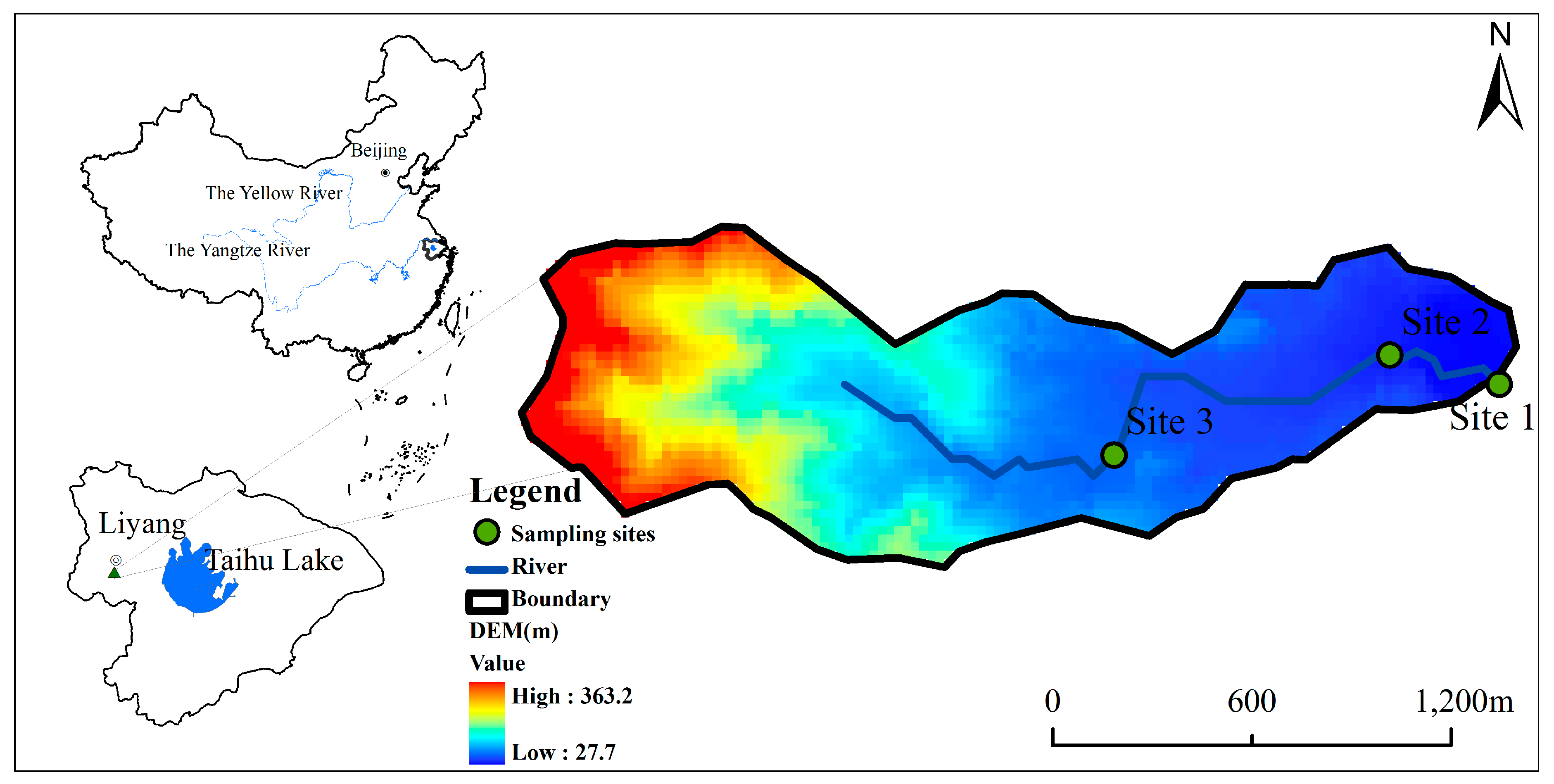
| Classification [37] | Hydrological | K Factor Value | Depth (mm) | Content (%) | |||
|---|---|---|---|---|---|---|---|
| Clay | Silt | Sand | Very Fine Sand | ||||
| TAUA | B | 0.04 | 0–16 | 15.12 | 41.98 | 42.9 | 3.01 |
| 16–29 | 17.41 | 37.69 | 44.9 | 3.11 | |||
| 29–56 | 16.84 | 40.26 | 42.9 | 3.01 | |||
| THSA | C | 0.04 | 0–14 | 19.22 | 53.06 | 27.72 | 1.97 |
| 14–24 | 12.9 | 59.38 | 27.72 | 1.97 | |||
| 24–36 | 12.73 | 57.3 | 29.97 | 2.12 | |||
| 36–100 | 13.26 | 31.21 | 55.53 | 3.50 | |||
2.3. Data Acquisition
2.3.1. Climate Data
2.3.2. Topographic Data
2.3.3. Soil Data
2.3.4. Land Use Data
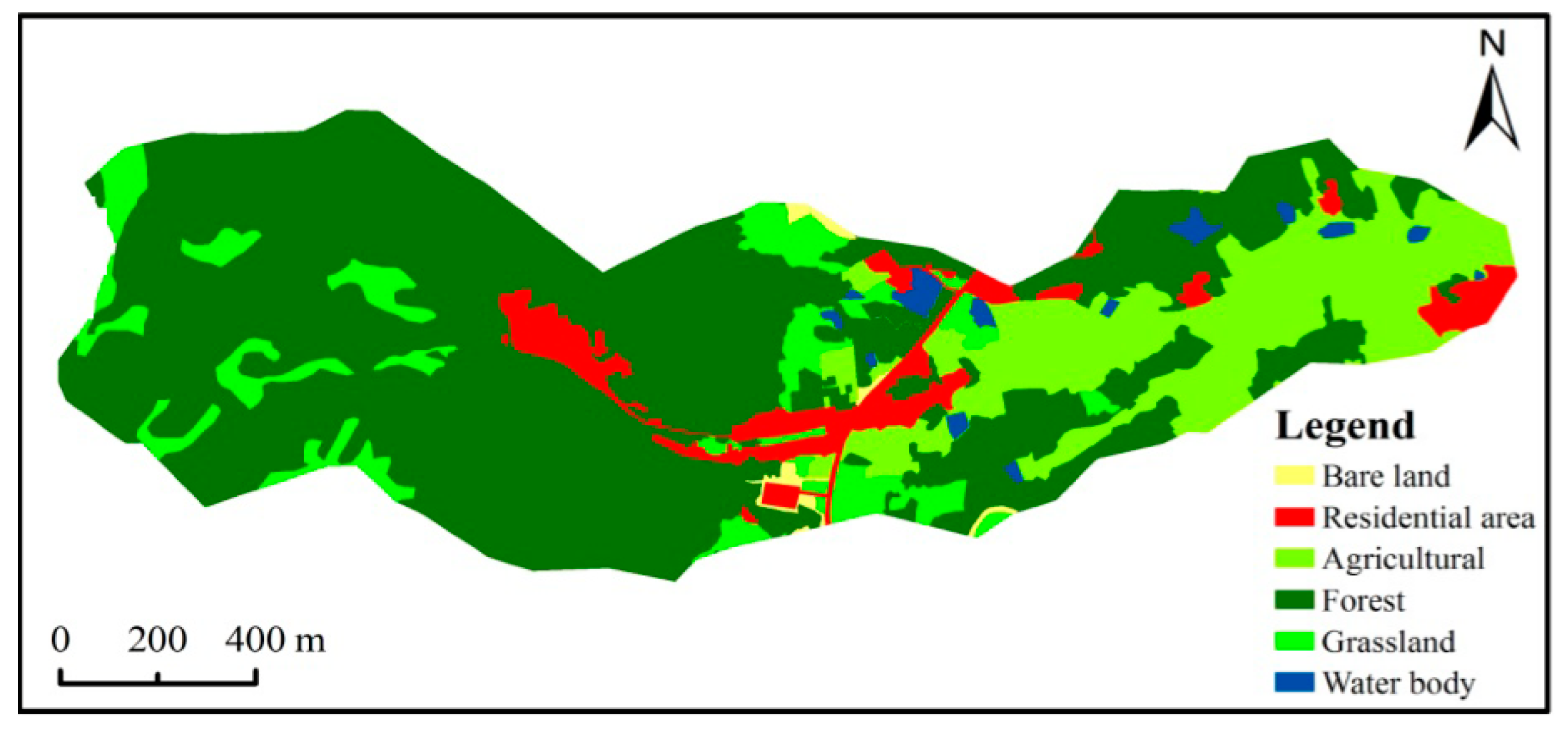
| Land Use | Date | Operation | Observation |
|---|---|---|---|
| Rice | 21 May | Seeding | Combined seeding machine |
| 12 June | Fertilization | Carbamide | |
| 10 July | Fertilization | Ammonium bicarbonate | |
| 10 August | Fertilization | Compound fertilizer | |
| 25 August | Weeding | Triadimefon/Diniconazole | |
| 3 September | Fertilization | Compound fertilizer | |
| 18 October | Grain harvesting | 5000–6000kg·ha−1 | |
| 25 October | Tillage | Moldboard | |
| Rape | 1 November | Seeding | Combined seeding machine |
| 10 December | Fertilization | Carbamide | |
| 5 February | Fertilization | Carbamide | |
| 10 March | Fertilization | Carbamide | |
| 11 March | Fertilization | Ammonium bicarbonate | |
| 10 May | Grain harvesting | 2200–3000kg·ha−1 | |
| 18 May | Tillage | Moldboard |
2.3.5. Hydrologic and Nutrient Loading Data
2.4. Parameter Sensitivity Analysis
2.4.1. Runoff Parameter
2.4.2. Nutrients parameters
2.5. Evaluation of Model Performance
3. Results and Discussion
3.1. Runoff Calibration
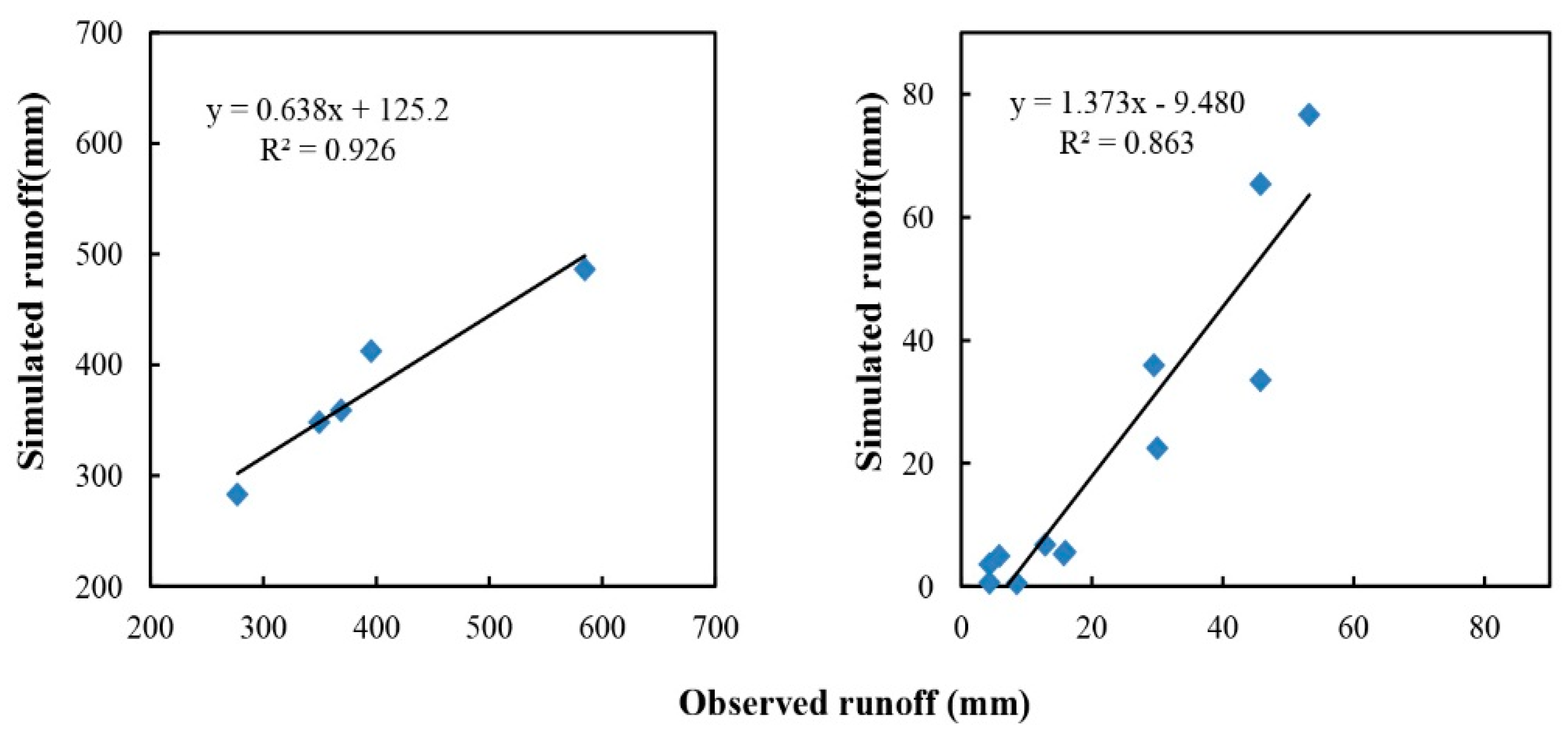
| Land Use | Curve Numbers for Hydrologic Soil Groups | |||||||
|---|---|---|---|---|---|---|---|---|
| Initial Values | Final Values | |||||||
| A | B | C | D | A | B | C | D | |
| Bare land | 65 | 75 | 82 | 95 | 65 | 75 | 82 | 95 |
| Residential area | 55 | 68 | 79 | 85 | 66 | 82 | 95 | 99 |
| Agricultural | 60 | 72 | 80 | 85 | 78 | 86 | 96 | 99 |
| Forest | 48 | 60 | 73 | 80 | 58 | 78 | 95 | 96 |
| Grass land | 42 | 69 | 79 | 87 | 50 | 83 | 95 | 98 |
| Items | Calibration | Validation | ||||||||
|---|---|---|---|---|---|---|---|---|---|---|
| R2 | E | E′ | RMSE | CRM | R2 | E | E′ | RMSE | CRM | |
| Annual scale | ||||||||||
| Run off | 0.93(0.76) * | 0.81(−5.32) | 0.65(−2.23) | 45.09(257.83) | 0.05(0.63) | 0.88(0.82) | 0.86(−8.00) | 0.65(−2.2) | 26.95(213.62) | −0.02(0.58) |
| Monthly scale | ||||||||||
| Run off | 0.86(0.55) | 0.59(−3.21) | 0.39(−1.33) | 11.24(21.58) | 0.04(0.62) | 0.84(0.75) | 0.65(−2.64) | 0.42(−1.75) | 10.65(20.31) | 0.02(0.59) |
| 0.87(0.78) | 0.81(−1.63) | 0.62(−0.55) | 8.71(15.16) | 0(0.45) | ||||||
| TN | 0.91(0.77) | 0.86(0.33) | 0.71(0.12) | 100(180.25) | 0.22(0.87) | 0.92(0.85) | 0.71(0.29) | 0.58(0.08) | 130.85(210.34) | 0.42(0.92) |
| TP | 0.66(0.38) | 0.37(−1.05) | 0.46(0.10) | 1.67(3.15) | 0.14(0.92) | 0.62(0.28) | 0.18(−1.26) | 0.37(−0.55) | 1.18(2.67) | 0.19(0.88) |
3.2. Runoff Validation
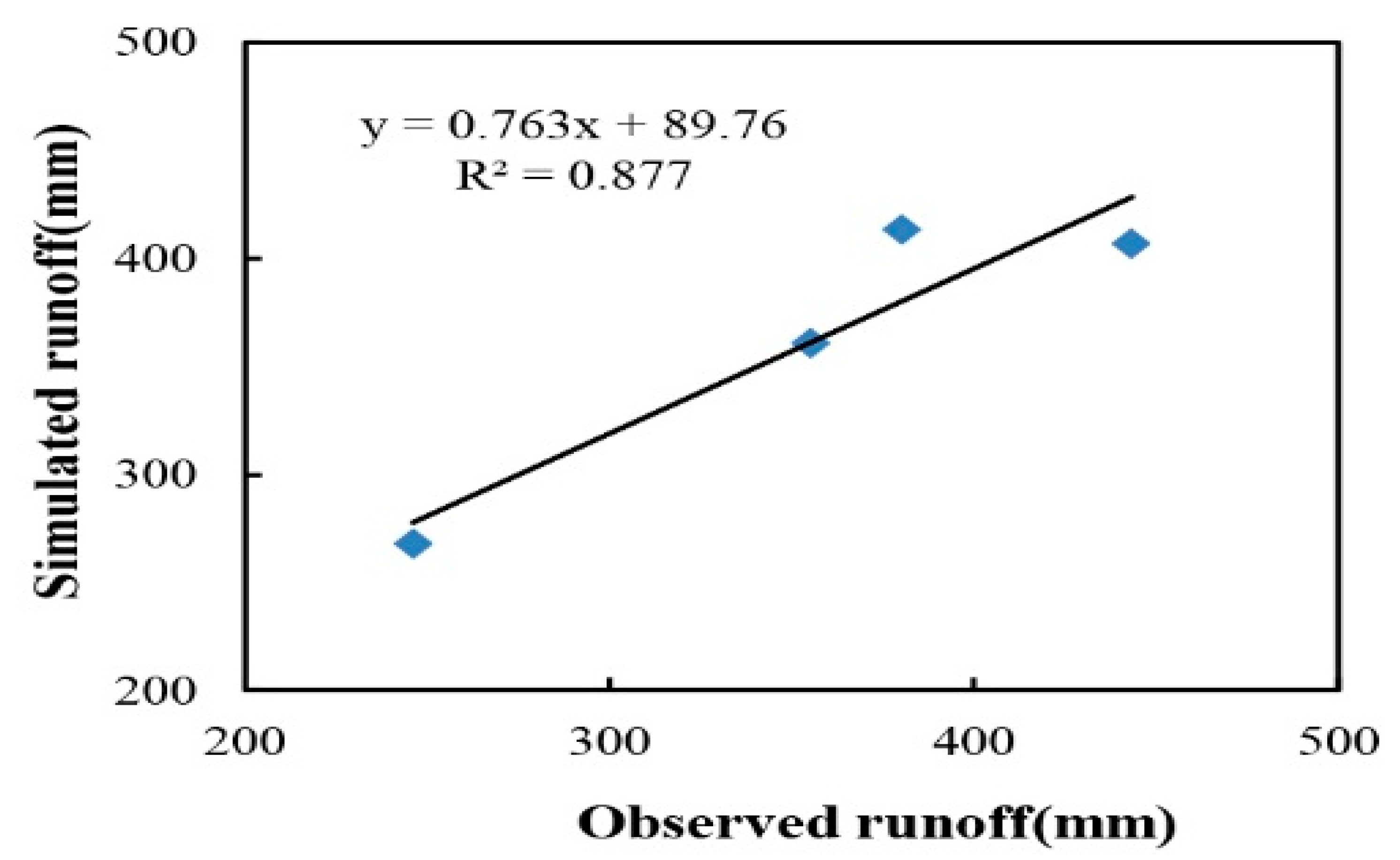
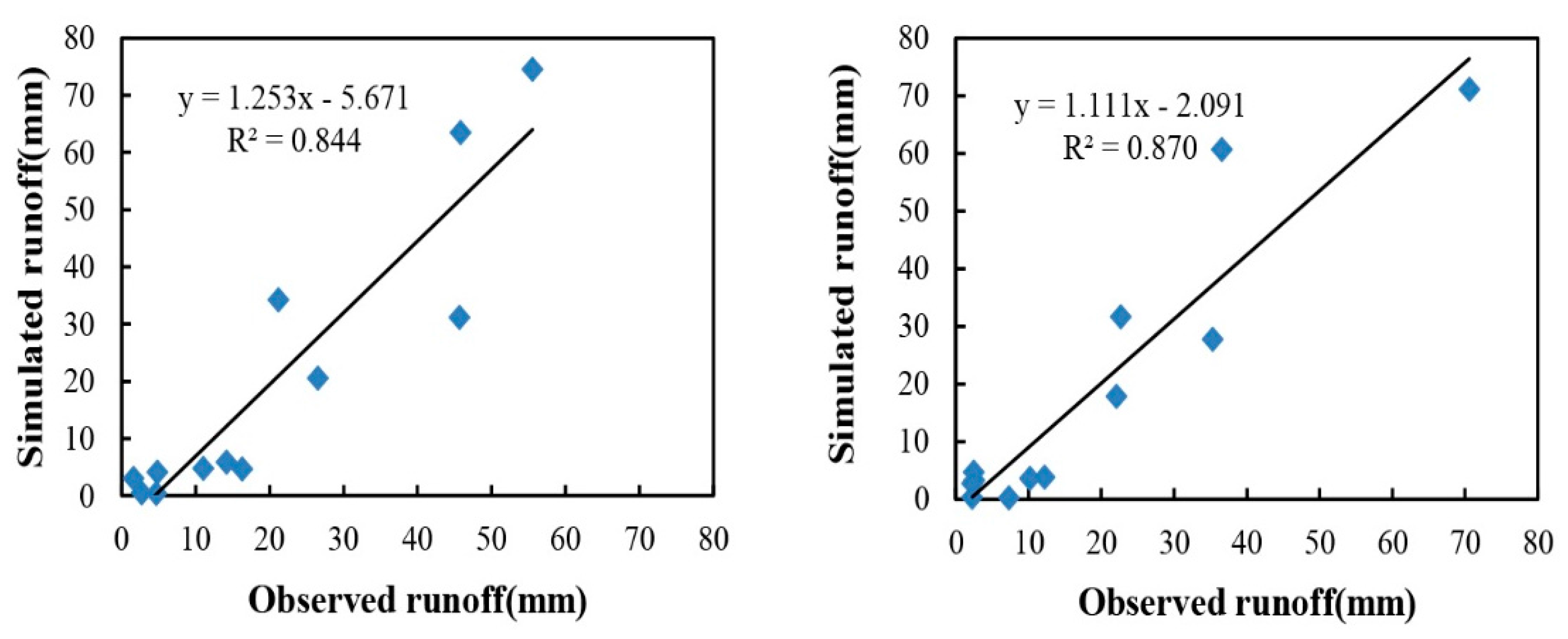
3.3. Nutrient
3.3.1. Results of the Parameter Sensitivity Analysis

| Input Parameters | Sensitivity Index for TN | Sensitivity Index for TP |
|---|---|---|
| Residue mass ratio | 0.04 | 0.39 |
| Root mass | −0.09 | −0.10 |
| Canopy cover | −0.26 | −0.32 |
| Fertilizer rate | 0.94 | 0.30 |
| Fertilizer depth | 0.00 | 0.00 |
| Fertilizer inorganic | 0.25 | 0.26 |
| Fertilizer organic | 0.69 | 0.04 |
3.3.2. Nutrient Calibration
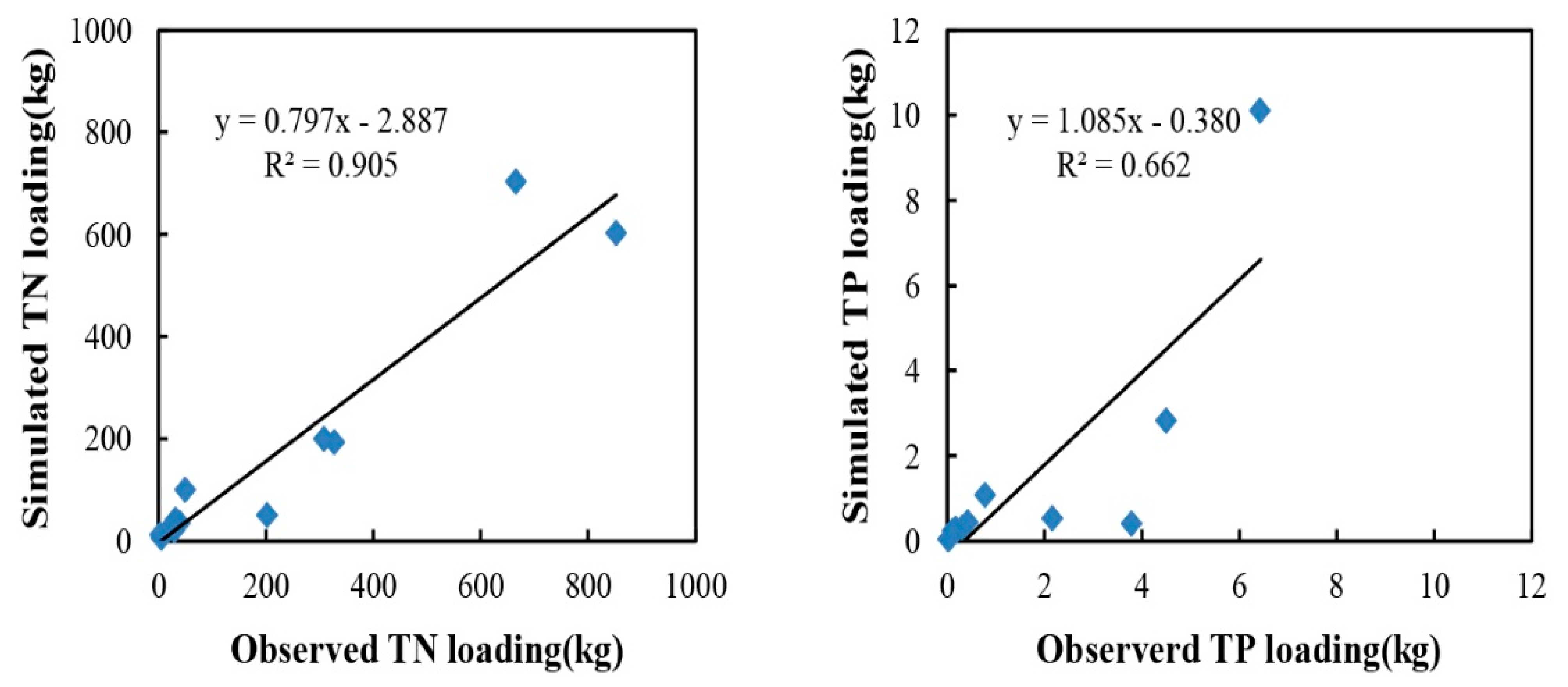
3.3.3. Nutrient Validation

4. Conclusions
Acknowledgments
Author Contributions
Conflicts of Interest
References
- Arnold, J.G.; Allen, P.M.; Bernhardt, G. A comprehensive surface-groundwater flow model. J. Hydrol. 1993, 142, 47–69. [Google Scholar] [CrossRef]
- Walton, R.S.; Hunter, H.M. Isolating the water quality responses of multiple land uses from stream monitoring data through model calibration. J. Hydrol. 2009, 378, 29–45. [Google Scholar] [CrossRef]
- Diaz-Ramirez, J.; Martin, J.L.; William, H.M. Modelling phosphorus export from humid subtropical agricultural fields: A case study using the HSPF model in the Mississippi Alluvial Plain. J. Earth Sci. Clim. Chang. 2013, 4. [Google Scholar] [CrossRef]
- Pease, L.M.; Oduor, P.; Padmanabhan, G. Estimating sediment, nitrogen, and phosphorous loads from the pipestem creek watershed, North Dakota, using AnnAGNPS. Comput. Geosci.UK 2010, 36, 282–291. [Google Scholar] [CrossRef]
- Liu, J.; Zhang, L.; Yuzhen, Z.; Hong, H.; Deng, H. Validation of an agricultural non-point source (AGNPS) pollution model for a catchment in the Jiulong river watershed, China. J. Environ. Sci.China 2008, 20, 599–606. [Google Scholar] [CrossRef]
- Akter, A.; Babel, M.S. Hydrological modeling of the Mun river basin in Thailand. J. Hydrol. 2012, 452, 232–246. [Google Scholar] [CrossRef]
- Yuan, Y.; Bingner, R.L.; Rebich, R.A. Evaluation of AnnAGNPS nitrogen loading in an agricultural watershed. J. Am. Water Resour. Assoc. 2003, 39, 457–466. [Google Scholar] [CrossRef]
- Bosch, D.; Theurer, F.; Bingner, R.; Felton, G.; Chaubey, I. Evaluation of the AnnAGNPS Water Quality Model. In Agricultural Non-Point Source Water Quality Models: Their Use and Application; John, E.P., Daniel, L.T., Rodney, L.H., Eds.; CSREES and EWRI: Florida, FL, USA, 1998; pp. 45–54. [Google Scholar]
- Beasley, D.B.; Huggins, L.F.; Monke, E.J. Answers: A model for watershed planning. Trans. ASAE 1980, 23, 0938–0944. [Google Scholar] [CrossRef]
- Arnold, J.G.; Srinivasan, R.; Muttiah, R.S.; Williams, J.R. Large area hydrologic modeling and assessment partI:Model development. J. Am. Water Resour. Assoc. 1998, 34, 73–89. [Google Scholar] [CrossRef]
- Bicknell, B.R.; Imhoff, J.C.; Kittle, J.L., Jr.; Donigian, A.S., Jr.; Johanson, R.C. Hydrological Simulation Program—Fortran: User’s Manual for Version 11; Environmental Protection Agency, National Exposure Research Laboratory Athens: Athens, GA, USA, 1997. [Google Scholar]
- Borah, D.K.; Bera, M. Watershed-scale hydrologic and nonpoint-source pollution models: Review of applications. Trans. ASAE 2004, 47, 789–803. [Google Scholar] [CrossRef]
- Merritt, W.S.; Letcher, R.A.; Jakeman, A.J. A review of erosion and sediment transport models. Environ. Model. Softw. 2003, 18, 761–799. [Google Scholar] [CrossRef]
- Aksoy, H.; Kawas, M.L. A review of hillslope and watershed scale erosion and sediment transport models. Catena 2005, 64, 247–271. [Google Scholar] [CrossRef]
- Shamshad, A.; Leow, C.S.; Ramlah, A.; Hussin, W.M.A.W.; Sanusi, S.A.M. Applications of AnnAGNPS model for soil loss estimation and nutrient loading for Malaysian conditions. Int. J. Appl. Earth Obs. 2008, 10, 239–252. [Google Scholar] [CrossRef]
- Chahor, Y.; Casali, J.; Gimenez, R.; Bingner, R.L.; Campo, M.A.; Goni, M. Evaluation of the AnnAGNPS model for predicting runoff and sediment yield in a small mediterranean agricultural watershed in Navarre (Spain). Agric. Water Manag. 2014, 134, 24–37. [Google Scholar] [CrossRef]
- Taguas, E.V.; Ayuso, J.L.; Pena, A.; Yuan, Y.; Perez, R. Evaluating and modelling the hydrological and erosive behaviour of an olive orchard microcatchment under no-tillage with bare soil in Spain. Earth Surf. Proc. Land. 2009, 34, 738–751. [Google Scholar] [CrossRef]
- Zema, D.A.; Denisi, P.; Taguas, R.E.V.; Gomez, J.A.; Bombino, G.; Fortugno, D. Evaluation of surface runoff prediction by AnnAGNPS model in a large Mediterranean watershed covered by olive groves. Land Degrad.Dev. 2015. [Google Scholar] [CrossRef]
- Shrestha, S.; Babel, M.S.; Das Gupta, A.; Kazama, F. Evaluation of annualized agricultural nonpoint source model for a watershed in the Siwalik hills of Nepal. Environ. Model. Softw. 2006, 21, 961–975. [Google Scholar] [CrossRef]
- Licciardello, F.; Zema, D.; Zimbone, S.; Bingner, R. Runoff and soil erosion evaluation by the AnnAGNPS model in a small mediterranean watershed. Trans. ASABE 2007, 50, 1585–1593. [Google Scholar] [CrossRef]
- Das, S.; Rudra, R.P.; Goel, P.K.; Gharabaghi, B.; Gupta, N. Evaluation of AnnAGNPS in cold and temperate regions. Water Sci. Technol. 2006, 53, 263–270. [Google Scholar] [CrossRef] [PubMed]
- Polyakov, V.; Fares, A.; Kubo, D.; Jacobi, J.; Smith, C. Evaluation of a non-point source pollution model, AnnAGNPS, in a tropical watershed. Environ. Model. Softw. 2007, 22, 1617–1627. [Google Scholar] [CrossRef]
- Parajuli, P.B.; Nelson, N.O.; Frees, L.D.; Mankin, K.R. Comparison of AnnAGNPS and SWAT model simulation results in USDA-CEAP agricultural watersheds in south-central Kansas. Hydrol. Process. 2009, 23, 748–763. [Google Scholar] [CrossRef]
- Yuan, Y.; Locke, M.A.; Bingner, R.L. Annualized agricultural non-point source model application for Mississippi Delta Beasley Lake watershed conservation practices assessment. J. Soil Water Conserv. 2008, 63, 542–551. [Google Scholar] [CrossRef]
- Baginska, B.; Milne-Home, W.; Cornish, P.S. Modelling nutrient transport in currency creek, NSW with AnnAGNPS and PEST. Environ. Model. Softw. 2003, 18, 801–808. [Google Scholar] [CrossRef]
- Yuan, Y.; Bingner, R.L.; Theurer, F.D.; Kolian, S. Water quality simulation of rice/crawfish field ponds within Annualized AGNPS. Appl.Eng. Agric. 2007, 23, 585–595. [Google Scholar] [CrossRef]
- Bingner, R.L.; Theruer, F.D. Annagnps Technical Processes Documentation, Version3.2; USDA-ARS: 2003. Available online: http://www.ars.usda.gov/Research/docs.htm?docid=70002003 (accessed on 15April2005).
- Young, R.A.; Onstad, C.A.; Bossch, D.D.; Anderson, W.P. AGNPS: A non-point source pollution model for evaluating agricultual watersheds. J. Soil Water Conserv. 1989, 44, 168–173. [Google Scholar]
- Sarangi, A.; Cox, C.A.; Madramootoo, C.A. Evaluation of the AnnAGNPS model for prediction of runoff and sediment yields in ST Lucia watersheds. Biosyst. Eng. 2007, 97, 241–256. [Google Scholar] [CrossRef]
- Zema, D.A.; Bingner, R.L.; Denisi, P.; Govers, G.; Licciardello, F.; Zimbone, S.M. Evaluation of runoff, peak flow and sediment yield for events simulated by the AnnAGNPS model in a belgian agricultural watershed. Land Degrad. Dev. 2012, 23, 205–215. [Google Scholar] [CrossRef]
- Wang, S.; Stiles, T.; Flynn, T.; Stahl, A.J.; Gutierrez, J.L.; Angelo, R.T.; Frees, L. A modeling approach to water quality management of an agriculturally dominated watershed, Kansas, USA. Water Air Soil Pollut. 2009, 203, 193–206. [Google Scholar] [CrossRef]
- Bingner, R.L.; Theurer, F.D. Topographic factors for RUSLE in the continuous-simulation watershed model for predicting agricultural, non-point source pollutants (AnnAGNPS). Soil erosion research for the 21st century. In Proceedings of the International Symposium, Honolulu, HI, USA, 3–5 January 2001; pp. 619–622.
- SCS. National engineering handbook, Section 4. In Hydrology; USDA: Washington, DC, USA, 1985. [Google Scholar]
- Renard, K.G.; Foster, G.; Weesies, G.; McCool, D.; Yoder, D. Predicting Soil Erosion by Water: A Guide to Conservation Planning with the Revised Universal Soil Loss Equation (RUSLE); United States Department of Agriculture: Washington, DC, USA, 1997. [Google Scholar]
- Theurer, F.D.; Clarke, C.D. Wash load component for sediment yield modeling. In Proceedings of the Fifth Federal Interagency Sedimentation Conference, 18–21 March 1991; pp. 18–21.
- Bingner, R.L.; Theurer, F.D.; Yuan, Y. AnnAGNPS Technical Processes; USDA-ARS: Washington, DC, USA, 2003. Available online: http://www.ars.usda.gov/Research/docs.%20htm (accessed on3 July 2015).
- Group of Soil Taxonomic, Institute of Soil Sciences, Chinese Academy of Sciences. The Chinese Soil Taxonomic Classification Retrieval (3); University of Science and Technology of China Pesss: Hefei, China, 2001. [Google Scholar]
- CMA. Specifications for Surface Meteorological Observation; China Meterological Press: Beijing, China, 2004. [Google Scholar]
- Saxton, K. Pullman; USDAARS: Washington, DC, USA, 1989. [Google Scholar]
- Wischmeier, W.H.; Smith, D.D. Predicting Rainfall Erossion Losses a Guide to Conservation Planning; Department of Agricultuel: Maryland, MD, USA, 1978; p. 537. [Google Scholar]
- Li, Z.; Yang, G.; Li, K. Influence of land use on nitrogen exports in Xitiaoxi typical sub-watersheds. J. Environ. Sci. China 2005, 678–681. [Google Scholar]
- Van Griensven, A.; Meixner, T.; Grunwald, S.; Bishop, T.; Diluzio, A.; Srinivasan, R. A global sensitivity analysis tool for the parameters of multi-variable catchment models. J. Hydrol. 2006, 324, 10–23. [Google Scholar] [CrossRef]
- Kisekka, I.; Migliaccio, K.W.; Munoz-Carpena, R.; Khare, Y.; Boyer, T.H. Sensitivity analysis and parameter estimation for an approximate analytical model of canal-aquifer interaction applied in the C-111 basin. Trans. ASABE 2013, 56, 977–992. [Google Scholar]
- Diaz-Ramirez, J.N.; McAnally, W.H.; Martin, J.L. Sensitivity of simulating hydrologic processes to gauge and radar rainfall data in subtropical coastal catchments. Water Resour. Manag. 2012, 26, 3515–3538. [Google Scholar] [CrossRef]
- Taguas, E.V.; Yuan, Y.; Bingner, R.L.; Gomez, J.A. Modeling the contribution of ephemeral gully erosion under different soil managements: A case study in an olive orchard microcatchment using the AnnAGNPS model. Catena 2012, 98, 1–16. [Google Scholar] [CrossRef]
- Ma, Y.; Tan, X.; Shi, Q. The simulation of agricultural non-point source pollution in shuangyang river watershed. In Computer and Computing Technologies in Agriculture,II,volumeI; Li, D., Zhao, C., Eds.; Springer: New York, NY, USA, 2009; Volume 293, pp. 553–561. [Google Scholar]
- Yuan, Y.; Bingner, R.L.; Rebich, R.A.; Asae, A. Application of AnnAGNPS for Analysis of Nitrogen Loadings from a Small Agricultural Watershed in the Mississippi Delta. Available online: http://naldc.nal.usda.gov/naldc/catalog.xhtml?id=47848 (accessed on 3 July 2015).
- Yuan, Y.; Bingner, R.L.; Theurer, E.D.; Rebich, R.A.; Moore, P.A. Phosphorus component in Annagnps. Trans.ASAE 2005, 48, 2145–2154. [Google Scholar] [CrossRef]
- Frey, H.C.; Mokhtari, A.; Danish, T. Evaluation of Selected Sensitivity Analysis Methods Based upon Applications to two Food Safety Process Risk Models; Department of Civil, Construction, and Environmental Engineering, North Carolina State University: Raleigh, NC, USA, 2003. [Google Scholar]
- Das, S.; Rudra, R.; Gharabaghi, B.; Gebremeskel, S.; Goel, P.; Dickinson, W. Applicability of AnnAGNPS for Ontario conditions. Cannect. Biosyst. Eng. 2008, 50, 1–11. [Google Scholar]
- Lenhart, T.; Eckhardt, K.; Fohrer, N.; Frede, H.-G. Comparison of two different approaches of sensitivity analysis. Phys. Chem. Earth 2002, 27, 645–654. [Google Scholar] [CrossRef]
- Legates, D.R.; McCabe, G.J. Evaluating the use of “goodness-of-fit” measures in hydrologic and hydroclimatic model validation. Water Resour. Res. 1999, 35, 233–241. [Google Scholar] [CrossRef]
- Loague, K.; Green, R.E. Statistical and graphical methods for evaluating solute transport models: Overview and application. J. Contam. Hydrol. 1991, 7, 51–73. [Google Scholar]
- Van Liew, M.W.; Arnold, J.G.; Garbrecht, J.D. Hydrologic simulation on agricultural watershed choosing between two models. Trans. ASABE 2003, 46, 1539–1551. [Google Scholar] [CrossRef]
- Rode, M.; Frede, H.G. Testing AGNPS for soil erosion andwater quality modeling in agricultural catchments in Hesse, Germany. Phys. Chem. Earth B Hydrol. OceansAtmos. 1999, 24, 297–301. [Google Scholar] [CrossRef]
- Suttles, J.B.; Validis, G.; Bosch, D.D.; Lowrance, R.; Sheridan, J.M.; Usery, E.L. Watershed-scalesimulation of sediment andnutrient loads in Georgia Coastal Plain Streams using theAnnualizedAGNPS model. Trans. ASAE 2003, 46, 1325–1335. [Google Scholar] [CrossRef]
© 2015 by the authors; licensee MDPI, Basel, Switzerland. This article is an open access article distributed under the terms and conditions of the Creative Commons Attribution license (http://creativecommons.org/licenses/by/4.0/).
Share and Cite
Luo, C.; Li, Z.; Li, H.; Chen, X. Evaluation of the AnnAGNPS Model for Predicting Runoff and Nutrient Export in a Typical Small Watershed in the Hilly Region of Taihu Lake. Int. J. Environ. Res. Public Health 2015, 12, 10955-10973. https://doi.org/10.3390/ijerph120910955
Luo C, Li Z, Li H, Chen X. Evaluation of the AnnAGNPS Model for Predicting Runoff and Nutrient Export in a Typical Small Watershed in the Hilly Region of Taihu Lake. International Journal of Environmental Research and Public Health. 2015; 12(9):10955-10973. https://doi.org/10.3390/ijerph120910955
Chicago/Turabian StyleLuo, Chuan, Zhaofu Li, Hengpeng Li, and Xiaomin Chen. 2015. "Evaluation of the AnnAGNPS Model for Predicting Runoff and Nutrient Export in a Typical Small Watershed in the Hilly Region of Taihu Lake" International Journal of Environmental Research and Public Health 12, no. 9: 10955-10973. https://doi.org/10.3390/ijerph120910955






